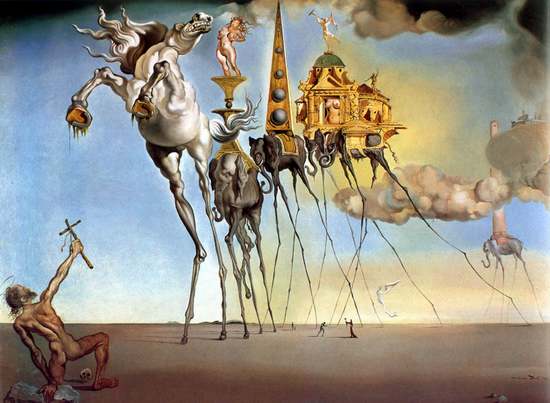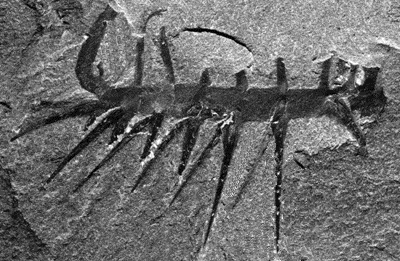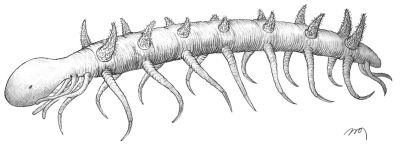
| Palaeos |  |
Panarthropoda |
| Ecdysozoa | Hallucigenia |
| Page Back: Lobopodia (2) | Unit Up: Ecdysozoa | Unit Home | Clade Up: Panarthropoda | Page Next: Luolishaniidae |
| Unit Back: Nematoida | Clade Down: Luolishaniidae | Dendrogram | References | Unit Next: Tardigrada |
|
Abbreviated Dendrogram
ECDYSOZOA |==SCALIDOPHORA `--+--NEMATOIDA | `--PANARTHROPODA |--Aysheaia `--+--TARDIGRADA `--+--Xenusiidae |--ONYCHOPHORA `--+--Diania |--+--Cardiodictyon | `--+--Hallucigenia | | |--Hallucigenia sparsa | | `--+--Hallucigenia fortis | | `--Hallucigenia hongmeia | `--+--Onychodictyon | `--Luolishaniidae `--+==Siberiidae `--+==DINOCARIDIDA `--ARTHROPODA |
Contents
Overview |
 Salvador Dalí. The Temptation of St. Anthony, 1946 (image copie dfrom Art Contrarian). Elephamts on stilts, and other weird stuff |
|
Along with Anomalocaris, Hallucigenia sparsa is probably one of the best known Cambrian animals. Originally believed to be an annelid worm, it was famously misinterpreted by Simon Conway Morris, who named the genus Hallucigenia sparsa because of its "bizarre and dream-like quality". Stephen Jay Gould and later commentators followed him in believing on this an upside-down and back-to-front animal, a creatuire that made no sense, walking on stilts like one of Salvadore Dali's elephants. Inspired by this and other strange Cambrian forms, Gould wroite Wonderful Life, a very readable popular science book on the Cambrian explosion, the premise of which is that Cambrian was full of bizarre short-lived phyla, of which only a tiny perceptage survived, and those only by pure chance or luck, not because any were less well adapted. Gould argued that if the tape of evolution was replayed thousands of times, different phyla would arise each time. Therefore, Gould argued, because it is only by random fluke that vertebrates became ascendent on earth, intelligence is very rare in the universe. Of course this anthropocentrically assumes that only humanoid vertebrates can be intelligent, a premise any good hard science fiction writer would laugh at.
In 1991, Lars Ramskold and Hou Xianguang, working with additional specimens of a "hallucigenid," Microdictyon, from the lower Cambrian Maotianshan shales of China, reinterpreted Hallucigenia as an Onychophore (velvet worm). They inverted it, interpreting the tentacles, which they believe to be paired, as walking structures and the spines as protective. Interestingly, none of the 30 or so known Burgess Shale specimens shows any sign of pairing in the large tentacles; nor do their Chinese counterparts. The pairing is based on a dissection of the actual fossil, which revealed what is probably a second tentacle structure. Ramskold and Hou also believe that the blob-like 'head' is actually a stain that appears in many specimens, not a preserved portion of the anatomy (Ramskold 1992) - Wikipedia
In the end Conway Morris and Gould came up with opposite evolutionary phylogenies. Gould had a model of evolution as a totally random bush, with absolutely no direction, Conway Morris not only placed many of the exotic Cambrian problematica as stem groups to current phyla (Conway Morris 1998), but even saw evolution and intelligence as converging on the same (humanoid) form (Conway Morris 2003), an anthropomorphic premise even less imaginative than Gould's, even if would give some scientific credibility to Star Trek's rubber-forehead aliens. One gets the feeling that maybe evolution is sometimes bush-like (Gould) and sometimes linear (Conway Morris) but more often it is oi somewhere in between, tending to emergent complexity as systems theory reveals.
Ironically, modern ideas of Hallucinogenia were almost as wrong as the original. Whilst the animal was no longer back to front and upside down, it was still walking on stilts, only now they were soft rubbery ones. The mechanics of this has of course never been questioned, until Maas et al 2007 discvered and described a long-legged lobopodian that had been preserved in three dimensions. It was realised that, unlike modern onychophores, the legs were held out horizontally; the animal may have crawled through the mud, but probably preferred clinging to the epibenthos. Add retractable spines (assuming this feature is shared with Orstenotubulus and modern tardigrades), and it turns out that Hallucinogenia really was a pretty weird critter after all MAK120426
Hallucigenia (= monotypal Family Hallucigeniidae Conway Morris, 1977
Range: Known from Early to Mid Cambrian of China & Nth Am; but doubtless would have had a wider distribution)
Phylogeny: Archonychophora : Cardiodictyon + ((Onychodictyon + Luolishaniidae) + * : Hallucigenia sparsa + (Hallucigenia fortis + Hallucigenia hongmeia))
Comments A small, long-legged lobopodian. There are seven pairs of legs, each with a corresponding pair of sclerites or spines, plus two pairs of longer but slighter anterior appendages two pairs in the head region in front of the most anterior pair of sclerites, and a further pair at the rear. The three known species, one trom the Burgess Shale and two from Chengjiang, hint at what must have been a much greater diversity. They differ in the shape of the sclerites (which only appear as long spines in the type species, H. sparsa, length of claws (long and curved in H. hongmeia, doubtless for clinging to epibenthos) and other minor features.. On the basis of general morphology, Ramsköld & Chen 1998 argue Hallucigenia is related to Microdictyon. Statistical-computational cladistic studies however place it near Cardiodictyon and Onychodictyon instead. Of course it may be that both these interpretations are valid.
Although in Liu et al 2011's analysis, Hallucigenia and the more derived forms share the synapomorphies of "elongate spine with plate-like armour on the trunk and the shape and size of spines variable" , Orstenotubulus also possesses elongate spine with plate-like armour on the trunk but is given a more basal position, which illustrates that spines are more likely a primitive rather than a derived feature of Cambrain lobopodians, with non-spiny forms being secondarily unarmoured. MAK120501

Hallucigenia sparsa (Walcott, 1911)
Horizon: Burgess Shale of British Columbia (Middle Cambrian - Cambrian V / Drumian)
Phylogeny: Hallucigenia: (Hallucigenia fortis + Hallucigenia hongmeia) + *
Comments famously reconstructed as a back to front upside down stilt walker, this small animal, only a few centimerers in length, is now known to be a fairly representative Cambrian lobopodian. it is distinguished by long paired dorsal spines along the back and three pairs of appendages at the anterior end of the trunk. Although in many ways a typical lobopodian, it is exceptional in the length of its spines. It is not known what the spines were made of and how much protection' they offered, if any. They do not seem to be preserved independent of the soft-shelled animals as carbonate or chitinous shells would probably be. The absense of such structures (or their presence as much shorter retractable spines, cones etc) in other lobopodian species implies that the purpose of these spines may not actually have been for defensive purposes (however most lobopodians do have spines of some sort). It is also not easy to explain why 30 or more specimens — each hypothesized to have seven pairs of rather long, flexible legs — do not show even one example of paired legs. MAK120427 (incorporating also content from Wikipedia)
Image: Hallucigenia sparsa, image © the Smithsonian Institute
Horizon: Chengjiang and Guanshan Lagerstätten, Yunnan, China, (Atdabanian to Toyonian - Early Cambrian)
Phylogeny: Hallucigenia: Hallucigenia sparsa + (Hallucigenia hongmeia + *)
Comments a wide ranging species, spanning much of the second half of the Early Cambrian (eight or ten million years), H. sparsa is currently reconstructed with a long slender head, whereas H. fortis still displays the expanded and rounded head of the stilt walking H. sparsa, implying it is simarily reconstructed back to front (if at least not upside down) Steiner et al 2012. The mouth is an antero-ventrally located Liu et al 2008, an "advanced" condition relative to most lobopodians, which was achieved a number of times. MAK120426

Hallucigenia hongmeia Steiner et al 2012
Horizon: Guanshan Lagerstätte (lower Wulongqing Formation, Yunnan, South China, (Early Toyonian age - Early Cambrian)
Phylogeny: Hallucigenia: Hallucigenia sparsa + (Hallucigenia fortis + *)
Comments Described as a "slender lobopodian with an annulated trunk with seven pairs of sclerites, eight pairs of legs, and a short tail. The sclerites are slightly sclerotized and show an antero-posterior differentiation with small, cone-shaped sclerites in the middle part and the largest spinose sclerites at the posterior end. A similar structure of sclerites can be seen in Onychodictyon ferox from the slightly older Yuanshan Formation (Chengjiang). Claws of the legs are long, curved, and also sclerotized." Steiner et al 2012. This newly discovered species of Hallucigenia is equipped with blunt cone-shaped sclerites, which, unlike the homologous very large, closely arranged and sharp sclerites of Hallucigenia sparsa , would not seem to serve any defensive purpose . The prominent claws in Hallucigenia hongmeia, similar to but larger than those Onychodictyon posesses, point to adaption for a specific habitat. The animal would seem to be less adapted for walking pr crawling on a muddy substrate and more to a climbing mode of life, perhaps on other benthic organisms or larger algae. Steiner et al 2012 p.120. Compare here the association of Aysheaia wirth sponges. Many lobopodians doubtless had a specialised lifestyle and commensual or mutualist interaction with specific plants and animals in their enviornment MAK120426
Image: Hallucigenia hongmeia, life reconstruction from Steiner et al 2012. Although the bulbous head indicates that this species is reconstructed back to front (compare the more recent reconstruction of Hallucigenia sparsa) the two pairs of small limbs not paired with sclerites show that this is indeed the correct orientation. MAK120427
| Page Back Lobopodia (2) | Unit Home | Page Top | Page Next: Luolishaniidae |
page MAK120425. All text content by M. Alan Kazlev is Creative Commons Attribution . Other content copyright respective authors or publishers